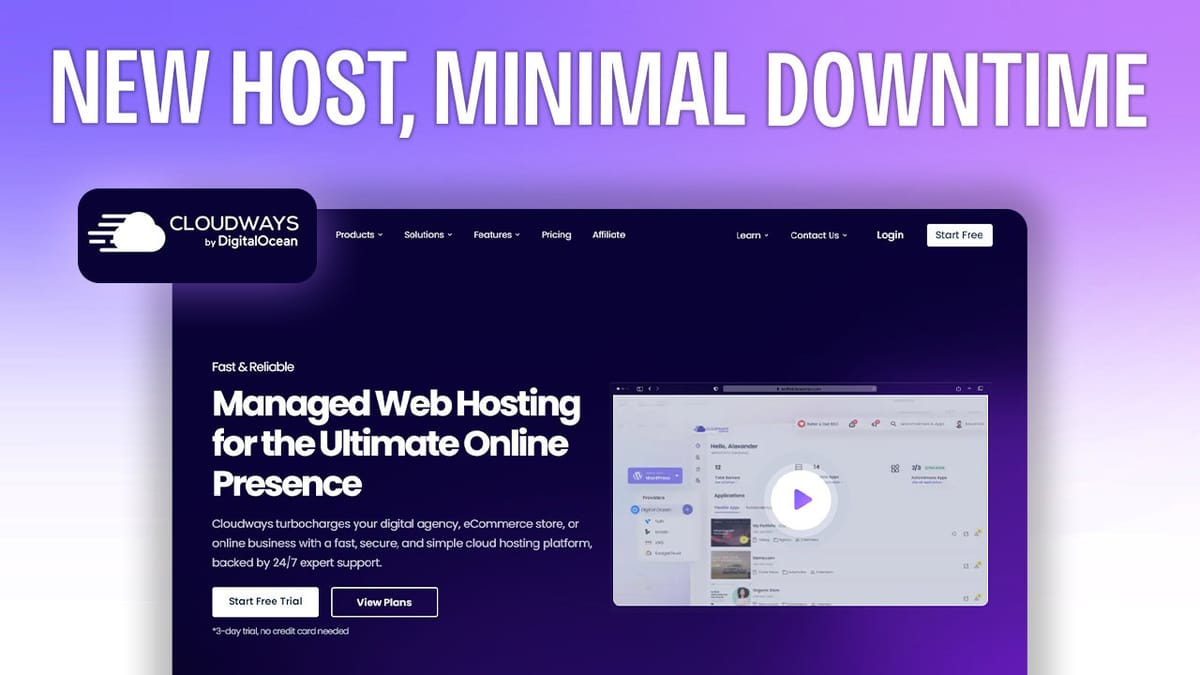Escaping cPanel: Easily Migrate Your WordPress Website (Featuring Cloudways)
Escape slow shared hosting and migrate your WordPress site to Cloudways for better performance. Follow this step-by-step guide for a smooth transition.

Many WordPress users struggle with slow-loading pages and WooCommerce errors, often blaming WordPress itself for these issues. However, the real culprit is usually underpowered shared hosting. In this guide, I’ll walk you through migrating your WordPress site from shared hosting to Cloudways, ensuring better performance and reliability.
While this is a sponsored video by Cloudways, I’ve been using their platform since 2017 and confidently recommend it regardless of compensation. My goal is to help improve the WordPress ecosystem by showing you how to move to better hosting.
What You Need [02:01]
To follow this migration guide, you’ll need:
- A Cloudways account (link in description)
- An existing WordPress website with administrator access
- Access to your DNS records (through your domain registrar or current host)
If you’re new to Cloudways, they offer one free migration. While I prefer handling migrations myself, this is a valuable option for those who want professional assistance.
Get CloudwaysPre-Migration Preparation [03:35]
Before starting any migration, proper preparation is crucial:
- Take a full backup of your existing website
- Document current server settings:
- PHP version
- Memory limits
- Max upload size
- Max execution time
Pro Tip: Access these settings through Tools > Site Health > Server in your WordPress dashboard. Use the “Copy site info to clipboard” button to save all relevant information.
Document Current Settings [04:01]
Take screenshots of sensitive areas like:
- WooCommerce transaction history
- Plugin settings
- Custom configurations
- Gateway settings
This creates a verification point for post-migration checking.
Lower DNS TTL Values [06:05]
If possible, lower your DNS TTL (Time To Live) values before migration:
- Access your DNS settings through your domain registrar or host
- Look for TTL settings on your root domain (@) record
- Lower the value to 1-5 minutes if allowed
- This enables faster DNS propagation during migration
External Integrations [07:48]
Document all external services connected to your WordPress site:
- Email marketing platforms
- Payment gateways
- Analytics tools
- API connections
- Custom scripts
Server Requirements [09:17]
Check your current website’s disk space usage:
- Go to Tools > Site Health > Directories and Sizes
- Note total space used
- Plan for future growth
- Choose a Cloudways server with appropriate capacity
Server Setup [10:43]
Creating your Cloudways server:
- Choose WordPress as your application
- Select your cloud provider (DigitalOcean, Vultr, Linode, etc.)
- Pick server size based on:
- Traffic volume
- Dynamic content needs
- Number of sites to host
Server sizing guidelines:
- E-commerce sites: Dedicated server recommended
- Static/brochure sites: Can share server resources
- Lead generation sites: 10-15 sites per server possible
PHP Configuration [16:30]
Match your PHP settings to your source server:
- Check PHP version
- Set memory limits
- Configure max execution time
- Adjust upload size limits
Remember: Matching PHP settings reduces potential migration issues.
Migration Process [27:37]
- Install Cloudways Migration plugin on source site
- Enter migration details:
- Destination URL
- SFTP credentials
- Database information
- Monitor migration progress
- Verify file transfer completion
Domain Configuration [32:49]
- Run search/replace for domain references
- Add domain in Cloudways panel
- Update DNS records:
- A record for root domain
- CNAME for www subdomain
- Install SSL certificate
- Configure www redirection
Post-Migration Tasks [46:05]
- Clear all caches
- Test functionality:
- Forms
- E-commerce features
- User registration
- Email notifications
- Verify SSL certificate
- Check backup systems
- Monitor site for 24-48 hours
Best Practices
- Document everything before starting
- Test thoroughly post-migration
- Use uptime monitoring
- Keep source site available until fully verified
- Consider using Cloudways’ free migration service if unsure
Conclusion
Moving from shared hosting to Cloudways can significantly improve your WordPress site’s performance and reliability. While the migration process requires attention to detail, following this guide ensures a smooth transition with minimal downtime.
Remember to maintain backups throughout the process and test thoroughly after migration. If you’re managing client sites, this process can be repeatedly used to upgrade their hosting infrastructure and improve their WordPress experience.
Need help with your migration? Drop a comment below, and I’ll be happy to assist.




